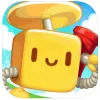Take a look inside 4 images
SpriteBox Coding
Pros: Good progression of challenges, easy to use for short chunks of time, and supports understanding of basic coding syntax.
Cons: Not explicit in how gameplay connects to coding concepts, and in-game help is pretty limited.
Bottom Line: This well-designed game introduces basic coding syntax and is best used for practice.
Most teachers would likely have students use SpriteBox Coding independently as a way of reinforcing or practicing what they've already done in the classroom. It's definitely intended for individual use and learning and not as an instructional tool. For example, after learning about loops in an unplugged activity, students could use SpriteBox to explore their use to accomplish tasks in the game. Through discussion, students could identify how using loops simplified their code creation.
SpriteBox Coding may also be appealing for parents who want to introduce their kids to simple coding concepts through gameplay. Working together with young kids would provide many opportunities for conversations about the ways code is used to solve problems. If you're looking for a more bite-sized version of the game for the Hour of Code, try SpriteBox : Code Hour.
SpriteBox Coding is a platform-style game (available on iOS and Android) that introduces kids to basic coding logic using both block- and text-based syntax. After choosing from a set of diverse characters, players use simple code blocks to get through obstacles in a game environment. The game features 70 puzzles, and as the player moves through the game, the challenges become more complex and new code blocks are introduced to solve problems.
Each player's avatar is helped by a little flying block that can be programmed to create a path through the different obstacles. Eventually, the block-based coding gives way to a text-based syntax similar to Swift (Java on Android devices). There are no written or spoken instructions; instead, short, easy-to-understand animations show how the blocks could potentially be used. Though this could have drawbacks if students get frustrated, it means the app can be used regardless of language or reading ability.
SpriteBox Coding is very thoughtfully designed to introduce young kids to essential coding concepts (e.g., loops, sequences, etc.). Challenges push them to try new things without getting too frustrated, and each level is short enough that students could progress using only small chunks of time. There are no in-game helps or hints if players get stuck, however.
Without teacher (or parent) support, very few students are likely to see what they're doing as coding. With proper explicit instruction, students will be able to see how the game employs those concepts and, in the process, deepen their understanding of how coding works. Since it can't stand alone to teach coding, the app's a nice way to practice concepts that are learned through more directed instructional activities. Completing the tasks and reflecting on how what they did connected to lessons would help students develop a deeper understanding.













